and the sample data file
and place them in the same folder on a WINTEL machine.
The sample data file is reproduced below. It contains the lower half of an agreement score matrix computed between the 31 supreme court justices who served on the court from 1945 to 2000.
TORSCA Method to get initial starting configuration PRE-ITERATIONS=3 Number Iterations to Improve starting config. DIMMAX=2,DIMMIN=1 Maximum & Minimum Number of Dimensions COORDINATES=ROTATE Rotate Coordinates so Principal Components lie along axes ITERATIONS=25 Maximum Number of Iterations REGRESSION=DESCENDING Monotone Regression for Similarities -- NONMETRIC MDS DATA,LOWERHALFMATRIX,DIAGONAL=PRESENT,CUTOFF=.01 Anything below .01 is Missing Data U. S. SUPREME COURT AGREEMENT SCORES Title 32 1 1 32 = # of Justices, Always set the next two numbers = 1 (12X,101F3.0) Format Statement For Dataset BURGER 100 BLACKMUN 81100 POWELL 86 80100 REHNQUIS 87 72 83100 STEVENS 71 77 74 67100 OCONNOR 88 72 86 87 71100 SCALIA -99 66 85 89 65 85100 KENNEDY -99 70-99 88 70 86 87100 -99 is the Missing Data Code SOUTER -99 72-99 78 75 81 77 84100 THOMAS -99 55-99 86 56 81 92 82 72100 GINSBURG -99 67-99 73 80 75 70 79 87 67100 BREYER -99-99-99 70 78 77 64 75 84 63 84100 RUTLEDGE -99-99-99-99-99-99-99-99-99-99-99-99100 MURPHY -99-99-99-99-99-99-99-99-99-99-99-99 86100 VINSON -99-99-99-99-99-99-99-99-99-99-99-99 63 64100 HARLAN 81 78-99-99-99-99-99-99-99-99-99-99-99-99-99100 BLACK 67 69-99-99-99-99-99-99-99-99-99-99 85 85 63 58100 DOUGLAS 39 42 42 33-99-99-99-99-99-99-99-99 78 79 59 50 77100 STEWART 77 75 80 74 75-99-99-99-99-99-99-99-99-99-99 78 67 58100 MARSHALL 54 65 57 46 65 51 50 50 53-99-99-99-99-99-99 70 66 70 69100 BRENNAN 53 64 56 46 65 52 51 52100-99-99-99-99-99-99 66 76 76 70 91100 WHITE 80 76 79 77 69 77 79 80 76 74-99-99-99-99-99 74 73 56 76 59 64100 WARREN -99-99-99-99-99-99-99-99-99-99-99-99-99-99-99 60 81 79 71 90 91 79100 CLARK -99-99-99-99-99-99-99-99-99-99-99-99-99-99 91 74 67 61 77-99 77 83 77100 FRANKFUR -99-99-99-99-99-99-99-99-99-99-99-99 58 61 70 86 60 55 79-99 67-99 63 71100 WHITTAKE -99-99-99-99-99-99-99-99-99-99-99-99-99-99-99 81 57 52 82-99 66-99 62 75 80100 BURTON -99-99-99-99-99-99-99-99-99-99-99-99 62 58 83 77 60 56-99-99 65-99 66 81 72 80100 REED -99-99-99-99-99-99-99-99-99-99-99-99 65 62 84 67 60 60-99-99 69-99 71 82 67-99 82100 FORTAS -99-99-99-99-99-99-99-99-99-99-99-99-99-99-99 63 68 76 72 89 87 75 85 74-99-99-99-99100 GOLDBERG -99-99-99-99-99-99-99-99-99-99-99-99-99-99-99 59 78 80 77-99 90 78 87 71-99-99-99-99-99100 MINTON -99-99-99-99-99-99-99-99-99-99-99-99-99-99 87 72 62 57-99-99-99-99 75 84 68-99 82 83-99-99100 JACKSON -99-99-99-99-99-99-99-99-99-99-99-99 57 57 75-99 57 53-99-99-99-99 75 78 80-99 74 73-99-99 73100 COMPUTE These two Lines STOP Must Always be IncludedYou must run the program from a DOS Window. To run the program type:
KYSTBIG
The program will then prompt you for three file names: the name of the data file (it calls this the "Control Card File"); the name of an output file that you can then print out; and the name of the file for the coordinates.
Control Card File? SUPKYST.DAT
Printer Output File? SUPREME.PRN
Coordinate Output File? SUPS.DAT
The program then runs the analysis and writes the output files to disk.
-
Produce graphs of the one and two dimensional coordinates that are in the
SUPS.DAT.
Interpret the one dimensional configuration. In light of what you know about the Supreme Court does in make sense to you?
and place it in the same folder with KYST.
The data file is reproduced below. It contains the lower half of a driving distance matrix computed between 10 U.S. cities -- Atlanta, Boise, Boston, Chicago, Cincinnati, Dallas, Denver, Los Angeles, Miami, and Washington, D.C..
PRINT HISTORY, PRINT DISTANCES This Option Prints out Some Useful Intermediate Output DIMMAX=3, DIMMIN=1 TORSCA REGRESSION=POLYNOMIAL=1 METRIC MDS DATA,LOWERHALFMATRIX,DIAGONAL=PRESENT,CUTOFF=0.0 U.S. MAP EXAMPLE 10 1 1 (10f5.0) 0000 2340 0000 1084 2797 0000 715 1789 976 0000 481 2018 853 301 0000 826 1661 1868 936 988 0000 1519 891 2008 1017 1245 797 0000 2252 908 3130 2189 2292 1431 1189 0000 662 2974 1547 1386 1143 1394 2126 2885 0000 641 2480 443 696 498 1414 1707 2754 1096 0000 COMPUTE STOP
-
Run this data set through KYST and get the coordinates. Plot the coordinates in
two dimensions. What do you see?
Change REGRESSION=POLYNOMIAL=1 to REGRESSION=ASCENDING and run it through KYST (the "ascending" tells KYST to do a Nonmetric MDS on dissimilarity data). Compare the Stress values for 1 to 3 dimensions with those obtained above and compare the two dimensional plot obtained with this option to that in part (a).
- First, use Epsilon to type in the
R code on page 28 of Gill. Be sure to enter the
code exactly as written!
- Name the file Gill_1.R and place it in a directory, for example, d:\R_Files (or something you will remember).
- Start R
- Under the "File" Menu, select "Source R Code". You will get a standard WINDOWS
directory-tree dialog box. Select the directory that you saved Gill_1.R in
and click "open". R will think for a second and then
you should see:
source("D:/r_files/gill_1.r")
- To run the program type:
run <- gill_1
This runs the program in the background and generates the two vectors of numbers, x and y.
- To see the entries of x, type:
x
and the entries will appear on the screen. Your computer screen should look something like the following:

Your numbers will look slightly different from mine because I tinkered with the computer code.
- It is always a good idea to keep a copy of everything you do in
R! To do this, go to the "File" menu and
select "Save to File". A standard WINDOWS file save dialog box comes up
with a default file name of "lastsave" with default extension of "*.TXT".
You can rename it to "Gill_1.Txt" if you like so you won't accidently
overwrite it later.
- Open "Gill_1.Txt" with Epsilon. You
should see everything that has appeared on the screen so far:
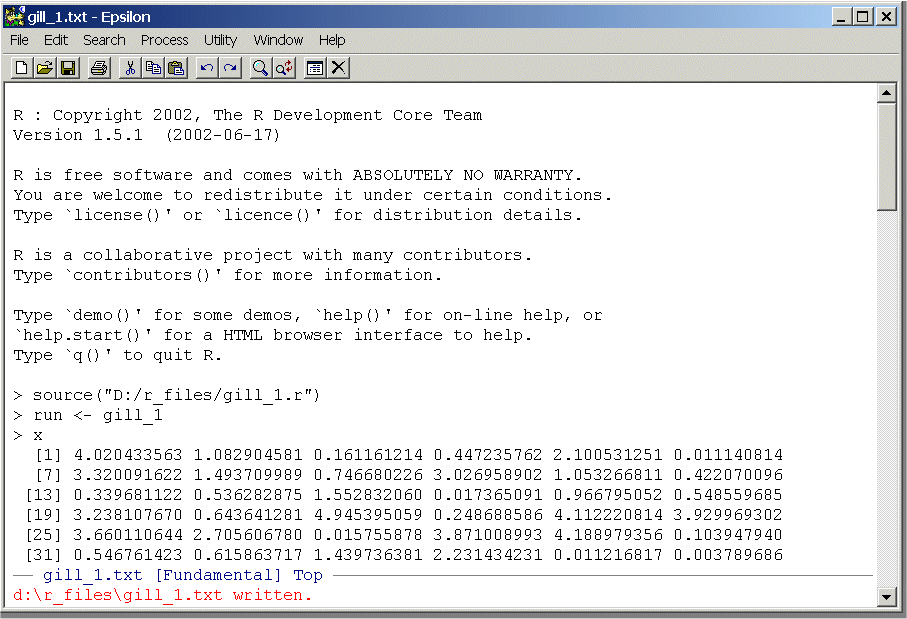
This is extremely handy for obvious reasons!
- Go back to R and display the entries of
y. Type:
y
and the entries will appear on the screen. Now, repeat the step above where you saved the screen contents to "Gill_1.Txt". Simply overwrite the previous version. Now go back to Epsilon and you will hear a "ding" and you should see this:
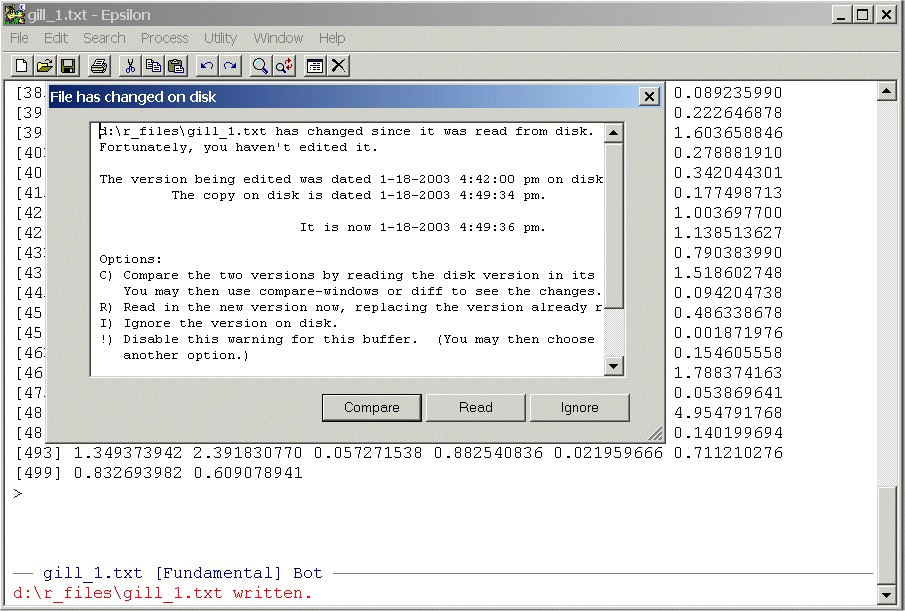
Click "Read" and you should see this:
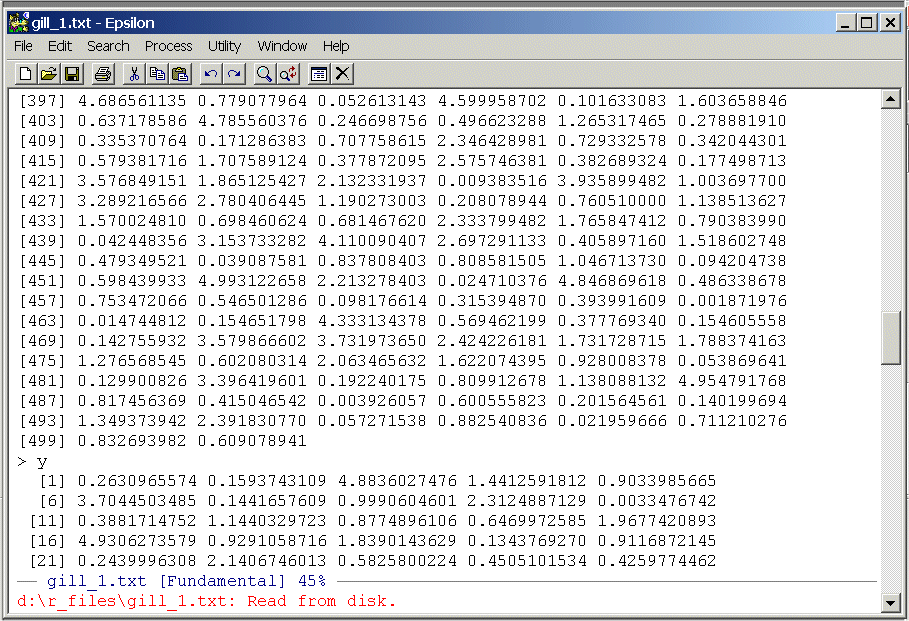
Again, my numbers will be a bit different from yours.
- Now, lets replicate the histograms that Gill shows on page 29. To do
this, use the command:
hist(x,breaks=50)
The "breaks=50" creates 50 bars. Now, right click on the image on the screen and select "copy as bitmap" (see below)
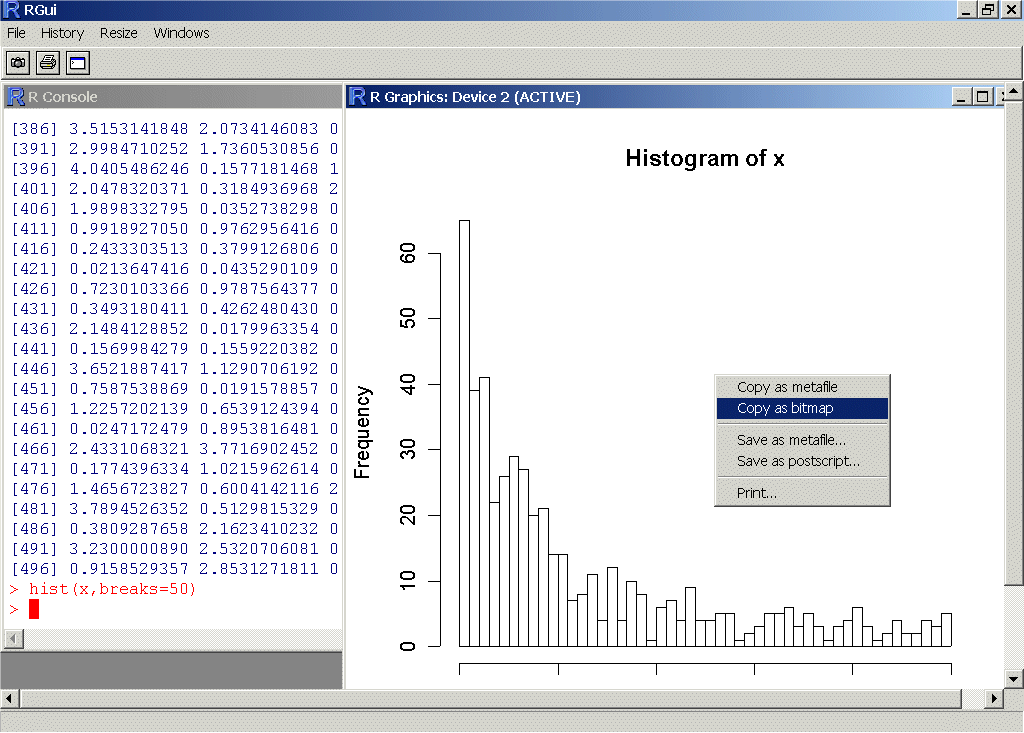
- Now you can go to WORD and simply paste the image into your
document (see below):

(Note that its slightly cut off in the screen shot.)
-
Repeat this process for the vector y and turn in both
graphs in WORD in your homework.
Produce a boxplot for both x and y. To do this in R type:
boxplot(x)
Your should see something like this:

Repeat this for the variable y and paste both of these graphs into your homework answer.
Report the means and standard deviations of x and y. To do this, use the commands:
mean(x)
and
sd(x)
Produce Histograms of both x and y with an exponential function overlay. To do this, first type the command:
hist(x,freq=F)
This produces a histogram. Minimize this picture so that the R command window has the focus (clicking on the R command window should bring it to the front as well). Now enter the command:
curve(dexp(x),add=T)
This command tells R to plot the best fitting exponential curve over the top of the existing plot. You should see something that looks like this:

Paste the plots for x and y into your homework answer.
The previous plot was a bit sloppy in that the top was cut off. To make better plots we need to tell R what the maximum value is for our exponential function. To do this, first enter the commands:
h <- hist(x,plot=F)
ylim <- range(0, h$density, dexp(0))
The first command retrieves the bar heights and places them in the variable h (later, try typing h at the command prompt). The second command calculates the range for the bars and the overlying density. Note that dexp(0) is the exponential evaluated at zero -- the maximum value of the function.
Now type:
hist(x, freq=F, ylim=ylim)
and the histogram will appear. Return the focus to the R command window and type:
curve(dexp(x), add=T)
You should see something like the following:
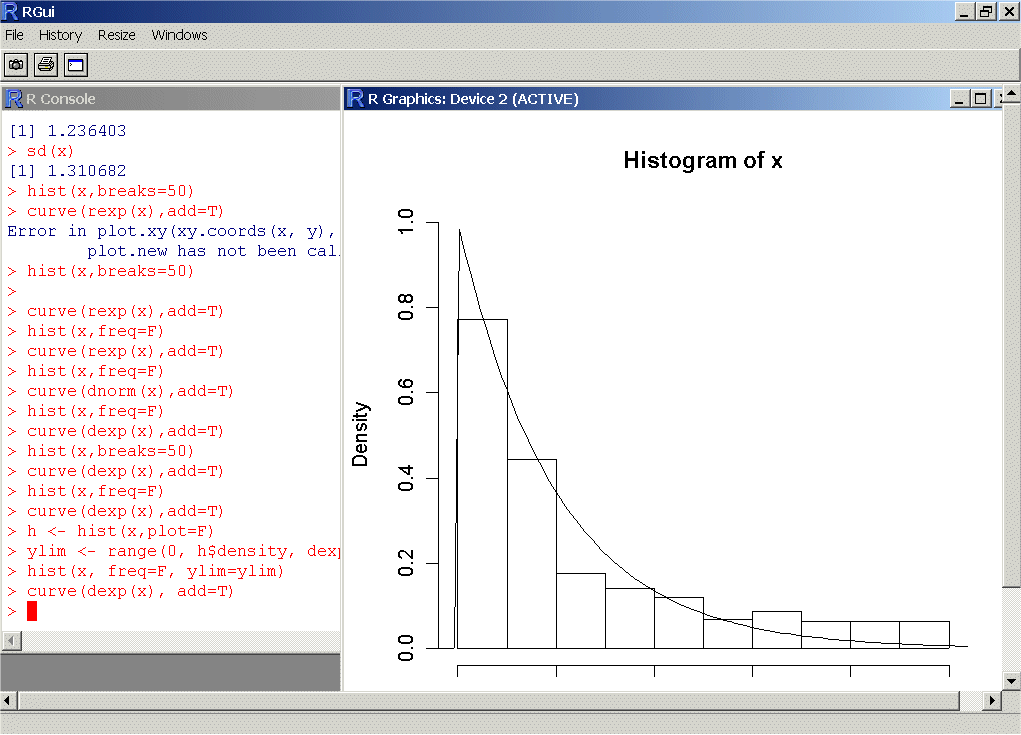
Paste the plots for x and y into your homework answer.